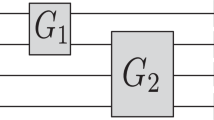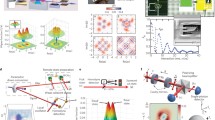Abstract
We present a model of discrete quantum computing focused on a set of discrete quantum states. For this, we choose the set that is the most outstanding in terms of simplicity of the states: the set of Gaussian coordinate states, which includes all the quantum states whose coordinates in the computation base, except for a normalization factor \(\sqrt{2^{-k}}\), belong to the ring of Gaussian integers \(\mathbb {Z}[i]=\{a+bi\ |\ a,b\in \mathbb {Z}\}\). We also introduce a finite set of quantum gates that transforms discrete states into discrete states and generates all discrete quantum states, and the set of discrete quantum gates, as the quantum gates that leave the set of discrete states invariant. We prove that the quantum gates of the model generate the expected discrete states and the discrete quantum gates of 2-qubits and conjecture that they also generate the discrete quantum gates of n-qubits.
Similar content being viewed by others
Explore related subjects
Discover the latest articles, news and stories from top researchers in related subjects.Notes
We usually represent these vectors by their decimal encodings, for example \(|1001\rangle =|9\rangle \), so in a system of n qubits the computational base is represented by \(\{|0\rangle ,|1\rangle ,\ldots ,|2^n-1\rangle \}\).
References
Schaller, R.R.: Moore’s law: past, present and future. Spectr. IEEE 34(6), 52–59 (1997)
Benioff, P.: The computer as a physical system: a microscopic quantum mechanical hamiltonian model of computers as represented by turing machines. J. Stat. Phys. 22(5), 563–591 (1980)
Feynman, R.P.: Simulating physics with computers. Int. J. Theor. Phys. 21(6), 467–488 (1982)
Feynman, R.P.: Quantum mechanical computers. Found. Phys. 16(6), 507–531 (1986)
Deutsch, D.: Quantum theory, the church-turing principle and the universal quantum computer. In: Proceedings of the Royal Society of London A: Mathematical, Physical and Engineering Sciences, vol 400, pp. 97–117. The Royal Society (1985)
Deutsch, D., Jozsa, R.: Rapid solution of problems by quantum computation. In: Proceedings of the Royal Society of London A: Mathematical, Physical and Engineering Sciences, vol 439, pp. 553–558. The Royal Society (1992)
Nielsen, M.A., Chuang, I.L.: Quantum Computation and Quantum Information. Cambridge University Press, Cambridge (2010)
Benjamin, S., Westmoreland, M.D.: Modal quantum theory. Found. Phys. 42(7), 918–925 (2012)
Ellerman, D.: Quantum mechanics over sets. arXiv:1310.8221v1 [quant-ph]
Hanson, A.J., Ortiz, G., Sabry, A., Tai, Y.-T.: Geometry of discrete quantum computing. J. Phys. A Math. Theor. 46(18), 185301 (2013)
Hanson, A.J., Ortiz, G., Sabry, A., Tai, Y.-T.: Discrete quantum theories. J. Phys. A Math. Theor. 47(11), 115305 (2014)
Chandrashekar, C.M., Srikanth, R., Laflamme, R.: Optimizing the discrete time quantum walk using a su(2) coin. Phys. Rev. A 77, 032326 (2008)
Lloyd, S., Dreyer, O.: The universal path integral. Quant. Inf. Process. 15(2), 959–967 (2016)
Long, G.-L.: General quantum interference principle and duality computer. Commun. Theor. Phys. 45(5), 825 (2006)
Long, G.-L., Liu, Y.: Duality computing in quantum computers. Commun. Theor. Phys. 50(6), 1303 (2008)
Long, G.-L., Liu, Y., Wang, C.: Allowable generalized quantum gates. Commun. Theor. Phys. 51(1), 65 (2009)
Gudder, S.: Mathematical theory of duality quantum computers. Quant. Inf. Process. 6(1), 37–48 (2007)
Long, G.-L.: Mathematical theory of the duality computer in the density matrix formalism. Quant. Inf. Process. 6(1), 49–54 (2007)
Wei, S.-J., Long, G.-L.: Duality quantum computer and the efficient quantum simulations. Quant. Inf. Process. 15(3), 1189–1212 (2016)
Lomonaco, S.J.: How to build a device that cannot be built. Quant. Inf. Process. 15(3), 1043–1056 (2016)
Kitaev, A.Y., Shen, A., Vyalyi, M.N.: Classical and Quantum Computation, vol. 47. American Mathematical Society, Providence (2002)
Oscar, B. P., Mor, T., Pulver, M., Roychowdhury, V., Vatan, F.: On universal and fault-tolerant quantum computing: a novel basis and a new constructive proof of universality for shor’s basis. In: 40th Annual Symposium on Foundations of Computer Science, New York City, NY, USA (1999)
Shi, Y.: Both toffoli and controlled-not need little help to do universal quantum computing. Quant. Inf. Comput. 3(1), 84–92 (2003)
Aharonov, D.: A simple proof that toffoli and hadamard are quantum universal. arXiv:quant-ph/0301040 (2003)
Kliuchnikov, V., Maslov, D., Mosca, M.: Fast and efficient exact synthesis of single qubit unitaries generated by Clifford and t gates. Quant. Inf. Comput. 13(7–8), 607–630 (2013)
Yaakov, S., Chai, W.D., Xie, N.: Improving ancilla states for quantum computation. Quant. Inf. Process. 15(4), 1445–1453 (2016)
Gatti, L. N., García-López, J.: Geometría de estados discretos en computación cuántica. In: 10th Andalusian Meeting on Discrete Mathematics, La Línea de la Concepción (Cádiz, Spain) (2017)
Lacalle, J., Gatti, L. N.: Extended Lagrange’s four-square theorem. J. Eur. Math. Soc. (submitted) (2018)
Giri, P.R., Korepin, V.E.: A review on quantum search algorithms. Quant. Inf. Process. 16(12), 315 (2017)
Grover, L.K.: Quantum mechanics helps in searching for a needle in a haystack. Phys. Rev. Lett. 79(2), 325 (1997)
Long, G.-L.: Grover algorithm with zero theoretical failure rate. Phys. Rev. A 64(2), 022307 (2001)
Grosswald, E.: Representations of Integers as Sums of Squares. Springer, New York (2012)
Giles, B., Selinger, P.: Exact synthesis of multiqubit Clifford+t circuits. Phys. Rev. A 87(3), 032332 (2013)
Author information
Authors and Affiliations
Corresponding author
Rights and permissions
About this article
Cite this article
Gatti, L.N., Lacalle, J. A model of discrete quantum computation. Quantum Inf Process 17, 192 (2018). https://doi.org/10.1007/s11128-018-1956-0
Received:
Accepted:
Published:
DOI: https://doi.org/10.1007/s11128-018-1956-0




